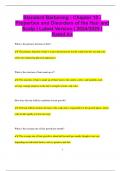Standard Barbering - Chapter 10 -
Properties and Disorders of the Hair and
Scalp | Latest Version | 2024/2025 |
Rated A+
What is the primary function of hair?
✔✔ The primary function of hair is to provide protection for the scalp from the sun and cold,
while also enhancing physical appearance.
What is the structure of hair made up of?
✔✔ The structure of hair is made up of three layers: the cuticle, cortex, and medulla, each
serving a unique purpose in the hair's strength, texture, and color.
How does the hair follicle contribute to hair growth?
✔✔ The hair follicle anchors the hair to the scalp and is responsible for the growth phase, where
cells divide rapidly to form new hair.
What is the average rate of hair growth per month?
✔✔ The average rate of hair growth is about half an inch per month, though it can vary
depending on individual factors such as genetics and diet.
1
,What is dandruff, and what causes it?
✔✔ Dandruff is a condition where the scalp sheds excess skin cells, often due to dryness or a
fungal infection, leading to flakes of skin on the scalp.
What are common causes of hair thinning?
✔✔ Common causes of hair thinning include hormonal imbalances, stress, nutritional
deficiencies, and genetic factors.
What is the difference between oily hair and dry hair?
✔✔ Oily hair has an overproduction of sebum, which makes the hair look greasy, while dry hair
lacks moisture and appears dull and brittle.
How can you tell if someone has a healthy scalp?
✔✔ A healthy scalp is clean, free of flakes, and free from irritation or redness, with normal oil
production and no signs of fungal infection.
What are the symptoms of scalp ringworm?
2
, ✔✔ Symptoms of scalp ringworm include itchy patches of skin on the scalp, redness, hair loss,
and the formation of scaly, crusty areas.
How does a diet rich in vitamins affect hair health?
✔✔ A diet rich in vitamins, especially biotin, vitamin E, and zinc, can help improve hair
strength, reduce hair loss, and promote healthy growth.
What is alopecia, and what are the main types?
✔✔ Alopecia is the medical term for hair loss, and the main types include androgenetic alopecia
(genetic hair loss), alopecia areata (patchy hair loss), and telogen effluvium (temporary hair loss
due to stress or illness).
What is seborrheic dermatitis, and how does it affect the scalp?
✔✔ Seborrheic dermatitis is a condition that causes inflamed, red, and flaky skin on the scalp,
often accompanied by excessive oil production.
What is the role of the sebaceous glands in hair health?
✔✔ Sebaceous glands produce sebum, an oily substance that helps to moisturize the scalp and
hair, preventing it from becoming dry and brittle.
3




